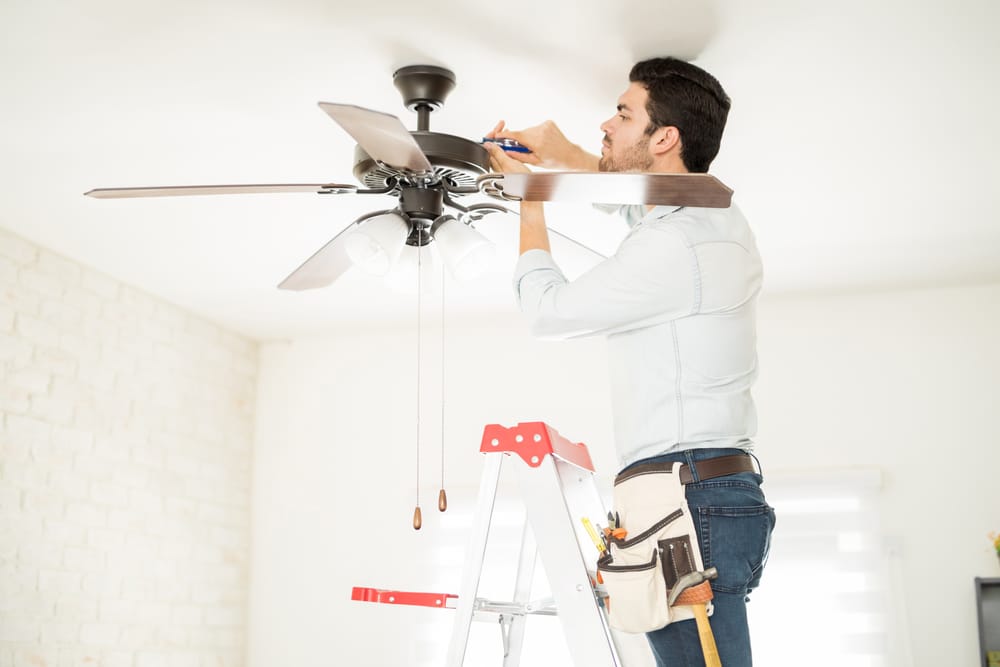Last Updated on
Ceiling fans are excellent items to have in your home. They can serve as a great alternative to air conditioning units and help circulate air around your rooms. These fans also look great and can add style depending on the position and room you place them in.
However, a common issue with ceiling fans is that they can often wobble and become unbalanced. Firstly, this is incredibly irritating. Secondly, a wobbly fan can often be dangerous. What if the warped blade broke from the fan mount and hit someone? It could potentially be a fatal injury. As a result, it is important to understand how to balance a ceiling fan. In the below article, we look at the common causes of wobble fans and give a guide on balancing them.
What Causes a Ceiling Fan to Become Unbalanced and Wobbly?
To start, you must understand the common causes of ceiling fan wobbles. Regardless of the design or style, you will find several common errors, including:
having a handyman is cool n all till it’s 3 am and he trynna take down the whole ceiling fan cus I’m hot and the fan not fanning 🥲
— ♡ (@jdenisefx) May 3, 2021
- Dirty or dusty fan blade materials.
- Wobbly fittings or loose screws.
- Misaligned fan blades.
- Uneven weight distribution between the blades.
Firstly, and most commonly, the fan is simply dirty. We often overlook items like fans, lamps, and ceilings when cleaning. Therefore, it is very easy for a ceiling fan ta accumulate dust. Over time, this dust can eventually cause issues and put too much pressure on the blades. Alternatively, it may affect the screws or the balance of the blades.
Secondly, the fixtures and screws may be loose. Typically, the blades of a fan are attached to a flywheel or the main fixture with screws. Due to constant movement and vibrations, these screws may loosen. Alternatively, the screws may simply not have been tightened properly during the initial installation.
Thirdly, over time, the fan blades can become misaligned. For the fan to work properly, the blades must be aligned properly in terms of vertical height from the ceiling. If one blade is lower than the others, it will cause the fan to lose balance and wobble.
Finally, the blades could also have different weights. A fan is made to exact specifications, and ideally, there should be no variance from the weight of the blades. There may be manufacturer defects, however. Even a small difference in weight may tip the blades in one direction and cause them to wobble.
Steps on How to Balance a Ceiling Fan
If you have a wobbly ceiling fan and make a loud noise, you can quickly rectify this issue yourself. It does require a ceiling fan balancing kit, but these are relatively cheap and available from most DIY stores. You will need the following equipment:
- A yardstick or ruler.
- Strong adhesive.
- A blade balancing kit.
- A stepladder.
- Screwdriver.
Step 1: Clean the Fan Mount, Blade Holder, and Blades
As mentioned above, a simple issue for a wobbly ceiling fan is an accumulation of dust and dirt. When cleaning, it is incredibly easy to overlook light fixtures and fans and concentrate on your furniture and items at eye level. As a result, the ceiling fan housing and fan blades can often be covered in dust.
The excess dust can put pressure on the fan blades and cause them to become bent or unaligned. It could ultimately affect the balance of the ceiling fan.
Before installing any balancing kits or checking the fixtures, clean your ceiling fan. Once you climb up the ladder, you may have shocked at just how dirty the fan blades and blade holder are. Don’t worry – we are sure this is a common thing that people forget to clean. Use a duster and polish to clean all areas of the ceiling fan firmly. It should include both the topside and underside of the blades, the mount, and the electrical cable.
Once you have cleaned your ceiling fans, you can check to see if this has improved the balance. If so, then the job is done. Often, a thorough cleaning can fix a wobbly ceiling fan, so this is always a great place to start. However, if the problem persists, you should turn to step 2.
Step 2: Check the Installation to Ensure Everything Is Tight
You now have a lovely clean ceiling fan. However, it is still wobbling and making a noise. Don’t worry. The next step is to check that the ceiling fan is installed properly. Over time, it is common for the fixtures and blades of ceiling fans to loosen. As the fan works, the bracket, screws, and other connection points may loosen due to the movement and vibrations.
Therefore, it is essential to check the fixture and fan blades before installing a ceiling fan balancing kit.
Climb your step ladder and inspect the screws where the blades attach to the flywheel. Use a screwdriver and turn it clockwise to test the strength and tightness of each screw. If you find any loose screws, use your screwdriver to tighten them.
Also, check that the ceiling fixture is secure. It is where the electrical cable goes into your roof. There should be a housing that protects the cable and makes the hole in the ceiling look presentable. Ensure this is appropriately tightened. Any small vibrations or loose materials could affect the balance of the blades.
Once you have checked the screws, the fixture, and the flywheel, you can turn the fan back on again and test it. Hopefully, this has solved the wobbling issue. If not, it’s time to check the blade alignment.
Sleeping with the ceiling fan on and minimal clothes weather is finally here and I luvvv it 🥰
— 𝐿𝒾𝓈𝑒𝓉𝓉𝑒 (@xolisettee) May 3, 2021
Step 3: Measure the Fan Blade Alignment of Each Blade
The final step before using a home improvement balancing kit is to check the blade alignment. As mentioned, this is another common issue. The ceiling fan could have been damaged during delivery. Alternatively, one of the blades could have become bent, misshapen, or warped from extreme temperatures. This misalignment would cause the fan to wobble.
Using a yardstick, tape measure, or ruler, you must measure the distance from the ceiling to the blade. It is important not to put pressure on the fan blade or move it in any way. It must hang loose so you can get a proper measurement. Take measurements toward the end of the blade and at the tip of the blade.
You must then repeat this process for the other fan blades of the ceiling fan. Each time, make sure you measure from the same point. If you measure from different points, you may not get an accurate reading. As a result, you could bend one of the fan blades for no reason.
With all the fan blade measurements, compare them. If they are the same, there is no need to take any action. However, if the blades have different measurements, you can bend them into position. Bend the blade that is unaligned gently, either up or down, to straighten it. Do this carefully, and do not put too much force on the blade; otherwise, it could snap.
Repeat this process until all of the ceiling fan blades are aligned. You can then turn on the fan and check again to see if this has fixed the issue. If the issue still persists, you can try installing a balancing kit.
Step 4: Use a Blade Balancing Kit to Even the Weight Distribution
You have now completely troubleshot your ceiling fan. So what is the issue? It could simply be a case of one fan blade weighing more than the others. Even a small deviation in weight may cause the fan’s blades to wobble.
To fix this, you can install a blade balancing kit. These are simple kits that you can buy from an electrical or DIY store. They include a bracket or clips that slot onto the ceiling fan blades. Also, they include different weights that are used to balance the ceiling fan blades. The weights may have adhesive pads, but you may also need separate glue to attach them to the clips.
As you have tested the ceiling fan, you should hopefully know which blade is causing the wobble. Use the kit first on the blade with a suspected wobble. The kit should have an instruction manual, and we advise reading this thoroughly first.
However, the same basic principle usually applies. First, the plastic clip is used to test each blade. Slide the clip onto the first blade – this should be around the midpoint of the blade. Turn the ceiling fan on, and check to see if this made any difference. If it stopped the wobble, you know this is the defective blade. If not, you would use the plastic clip and test each blade subsequently until you found the guilty culprit.
Once you have found the problem blade, remove the clip. Then place one of the weights in the centre of the blades, at the same point where the clip was attached. With the adhesive pad or glue, stick the weights firmly to the blade. You can then test the ceiling fan once more – hopefully, this should have solved the issue.
It is a relatively simple fix, but it does require a little patience and testing. You may get lucky and find the perfect balancing solution immediately. Alternatively, you may have to test each of the fan’s blades before getting the result you want. When trying ceiling fans, it is also essential to check them at each speed setting. In most instances, the wobble becomes more pronounced at a higher speed setting.
Coins Also Do the Trick
There is an alternative if you do not want to purchase a balancing kit for your ceiling fans. You can use pennies instead of the clip and weights. This method is essentially the same as the above step 4 but may require a little more testing and adjustments.
Ceiling Fan FAQs
Is It Ok for a Ceiling Fan to Wobble?
Yes, however, over time, this may cause damage. If the fan’s blades are unaligned, the wobble may become more pronounced over time. Eventually, the fan blades may come loose and cause harm to someone if they fly from the housing.
How Much Are Ceiling Fan Balancing Kits?
These are typically inexpensive kits and can be brought from most DIY and home improvement stores. You can usually pick up a kit for less than $15.
What if My Ceiling Is Uneven?
It is a more serious problem. Hopefully, your ceiling is level and can house a ceiling fan comfortably. However, if it is uneven, this may mean that your fan will never run straight. Before installing a fan, consider using a spirit level on the ceiling to check if it is level.
Managed to repair my ceiling fan light kit with replacement parts, and even reconnected it without electrocuting myself. pic.twitter.com/JrLsrPvBNn
— Scott Ladewig (@Ladewig) May 2, 2021
Enjoy Your Fan
Learning how to balance a ceiling fan will not only get rid of annoyance but will also keep your home safe. Knowing the common causes of wobbly fans is the first step in fixing them. Once you’ve pinpointed the reason, you’ll be able to fix your problem better.
Does your home have a ceiling fan? Have you had any issues with it? Let us know in the comments.
Paul is the type of person who never met a problem he couldn’t fix. He can always be found tinkering with something in his house, even if it isn’t broken! His tips and tricks are often shared on our site. He’s the one you call when something breaks because he has been known to improvise fixes for everything from leaky faucets to malfunctioning dryers.



